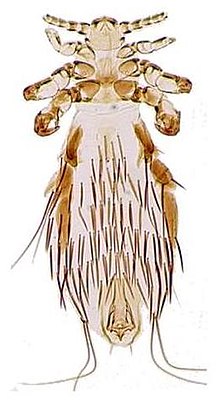| Phthiraptera Temporal range:
| |
|---|---|

| |
| Light micrograph of Fahrenholzia pinnata | |
| Scientific classification | |
| Domain: | Eukaryota |
| Kingdom: | Animalia |
| Phylum: | Arthropoda |
| Class: | Insecta |
| Order: | Psocodea |
| Suborder: | Troctomorpha |
| Infraorder: | Nanopsocetae |
| Parvorder: | Phthiraptera Haeckel, 1896 |
| Clades[1] | |
Louse (pl.: lice) is the common name for any member of the clade Phthiraptera, which contains nearly 5,000 species of wingless parasitic insects. Phthiraptera has variously been recognized as an order, infraorder, or a parvorder, as a result of developments in phylogenetic research.[1][2][3]
Lice are obligate parasites, living externally on warm-blooded hosts which include every species of bird and mammal, except for monotremes, pangolins, and bats. Lice are vectors of diseases such as typhus.
Chewing lice live among the hairs or feathers of their host and feed on skin and debris, whereas sucking lice pierce the host's skin and feed on blood and other secretions. They usually spend their whole life on a single host, cementing their eggs, called nits, to hairs or feathers. The eggs hatch into nymphs, which moult three times before becoming fully grown, a process that takes about four weeks. Genetic evidence indicates that lice are a highly modified lineage of Psocoptera (now called Psocodea), commonly known as booklice, barklice or barkflies. The oldest known fossil lice are from the Cretaceous.[4]
Humans host two species of louse—the head louse and the body louse are subspecies of Pediculus humanus; and the pubic louse, Pthirus pubis. The body louse has the smallest genome of any known insect; it has been used as a model organism and has been the subject of much research. Lice were ubiquitous in human society until at least the Middle Ages. They appear in folktales, songs such as The Kilkenny Louse House, and novels such as James Joyce's Finnegans Wake. They commonly feature in the psychiatric disorder delusional parasitosis. A louse was one of the early subjects of microscopy, appearing in Robert Hooke's 1667 book, Micrographia.
- ^ a b Cite error: The named reference
deMoya2021was invoked but never defined (see the help page). - ^ Cite error: The named reference
Johnson2021was invoked but never defined (see the help page). - ^ Cite error: The named reference
catlifewas invoked but never defined (see the help page). - ^ Zhang, Y.; Rasnitsyn, A. P.; Zhang, W.; Song, F.; Shih, C.; Ren, D.; Wang, Y.; Li, H.; Gao, T. (2024). "Stem chewing lice on Cretaceous feathers preserved in amber". Current Biology. 34 (4): 916–922.e1. Bibcode:2024CBio...34E.916Z. doi:10.1016/j.cub.2024.01.027. PMID 38320551.